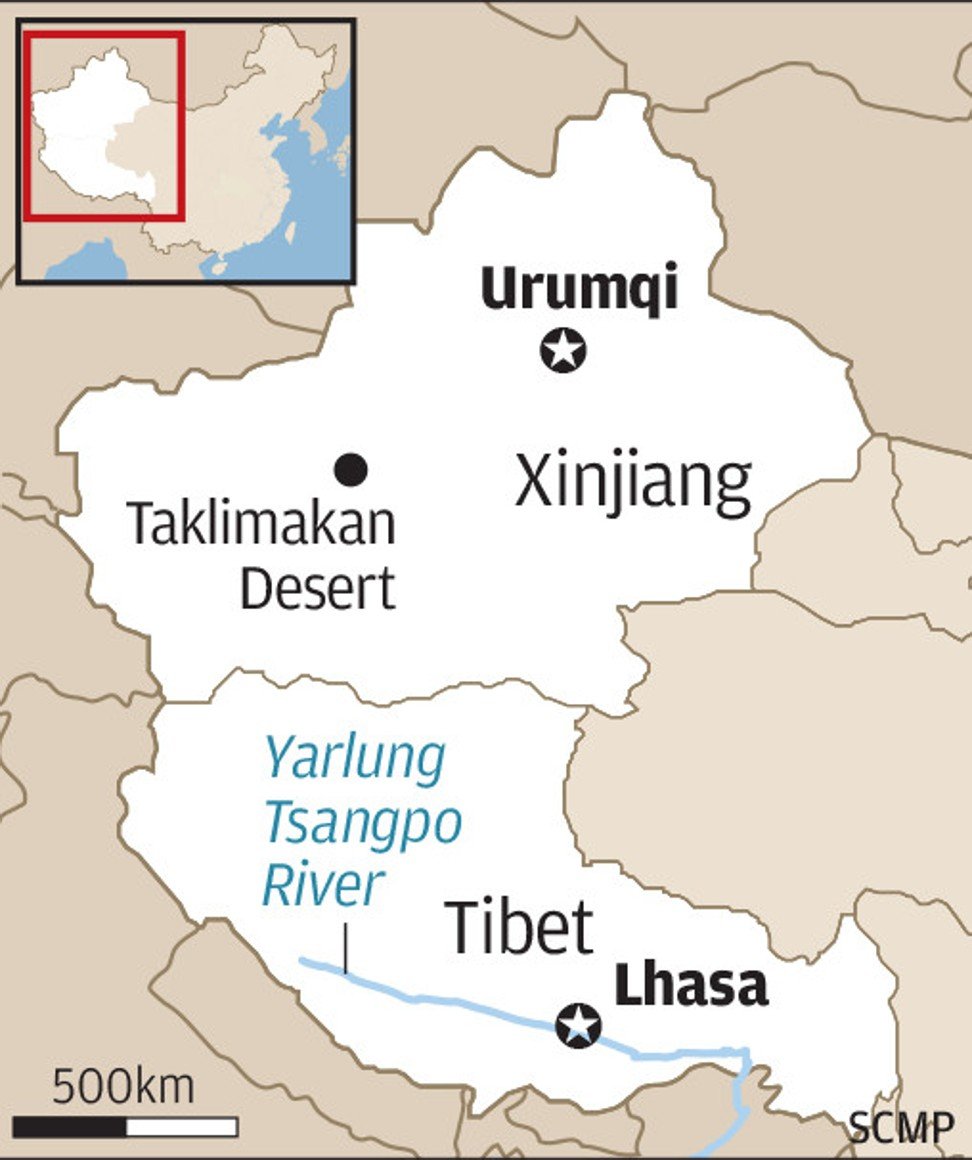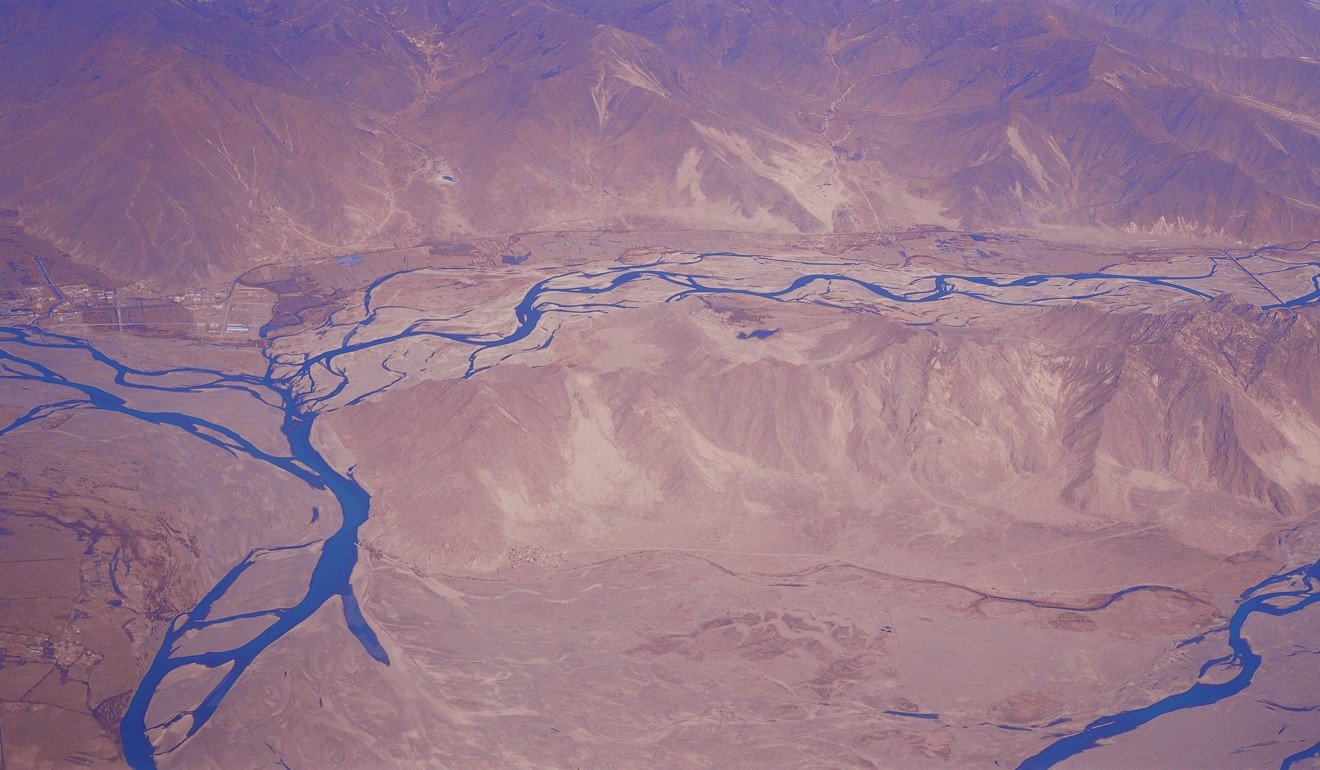Stephen Chen
 The proposed tunnel, which would drop down from the world’s highest plateau in multiple sections connected by waterfalls, would “turn Xinjiang into California”, one geotechnical engineer said.
The proposed tunnel, which would drop down from the world’s highest plateau in multiple sections connected by waterfalls, would “turn Xinjiang into California”, one geotechnical engineer said.
China’s longest tunnel is the eight-year-old 85km Dahuofang water project in Liaoning province, while the world’s longest tunnel is the 137km main water supply pipe beneath the city of New York.
However, the Chinese government started building a tunnel in the centre of Yunnan province in August that will be more than 600km long, local media reported. Comprising more than 60 sections, each wide enough to accommodate two high-speed trains, it will pass through mountains several thousand metres above sea level in an area plagued by unstable geological conditions.
Researchers said building the Yunnan tunnel would be a “rehearsal” of the new technology, engineering methods and equipment needed for the Tibet-Xinjiang tunnel, which would divert the Yarlung Tsangpo River in southern Tibet to the Taklimakan Desert in Xinjiang. Downstream, in India, the river becomes the Brahmaputra, which joins the Ganges in Bangladesh.
The Tibetan Plateau stops the rain-laden Indian Ocean monsoon from reaching Xinjiang, with the Gobi Desert in the north and the Taklimakan Desert in the south leaving more than 90 per cent of the region unsuitable for human settlement.
However, the Taklimakan sits right at the foot of the Tibetan Plateau, which is known as the water tower of Asia. The more than 400 billion tonnes of water it releases each year – almost enough to fill Lake Erie in the United States – also feeds the source of other major rivers, including the Yellow, Yangtze, Mekong (known in China as the Lancang) and the Ganges.
The earliest proposals to divert water from Tibet to Xinjiang were made by Qing dynasty officials Lin Zexu and Zuo Zongtang in the 19th century. In recent decades, Chinese government branches, including the Ministry of Water Resources, have come up with engineering blueprints involving huge dams, pumps and tunnels.
The project’s enormous cost, engineering challenges, possible environmental impact and the likelihood of protests by neighbouring countries have meant it has never left the drawing board, but Zhang Chuanqing, a researcher at the Chinese Academy of Sciences’ Institute of Rock and Soil Mechanics in Wuhan, Hubei province, said China was now taking a quiet, step-by-step approach to bring it to life.
“The water diversion project in central Yunnan is a demonstration project,” said Zhang, who has played a key role in many major Chinese water tunnel projects, including the one in Yunnan. “It is to show we have the brains, muscle and tools to build super-long tunnels in hazardous terrains, and the cost does not break the bank.”
The construction of the tunnel on the Yunnan-Guizhou Plateau, the country’s second-highest, would make political leaders more confident about the Tibet-Xinjiang project and more likely to approve it, he said.
The Yunnan-Guizhou Plateau in southwest China is, like the Tibetan Plateau, an earthquake-prone zone with many active faults.
“Fault zones are our biggest headache,” Zhang said. “If we can secure a solution, it will help us get rid of the main engineering obstacles to getting water from Tibet to Xinjiang.”
The solution they came up with was inspired by subway trains, whose carriages are connected by elastic joints. In the tunnel, Zhang said, flexible materials that were also waterproof and strong would be used to bind concrete pipes together when they passed through fault zones.
 The Yunnan tunnel and support facilities will take eight years to build at an estimated cost of 78 billion yuan (US$11.7 billion). It will carry more than three billion tonnes of water each year from northwestern Yunnan to the province’s dry centre and directly benefit more than 11 million people, according to the provincial government.
The Yunnan tunnel and support facilities will take eight years to build at an estimated cost of 78 billion yuan (US$11.7 billion). It will carry more than three billion tonnes of water each year from northwestern Yunnan to the province’s dry centre and directly benefit more than 11 million people, according to the provincial government.
The Yunnan Daily said the tunnel would create 3.4 million jobs, more than 30,000 hectares of new farmland and give the local economy a 330 billion yuan boost.
Wang Wei, a researcher who helped draft the latest Tibet-Xinjiang water tunnel proposal, which was submitted to the central government in March, said more than 100 scientists formed different teams for the nationwide research effort.
The team he was part of was led by China’s top tunnelling expert, Wang Mengshu. It suggested the government drain the Yarlung Tsangpo River at Sangri county in southern Tibet, near the disputed border with India.
Sangri county featured a large, relatively flat valley that was ideal for the engineering project. An artificial island would be built in the middle of the river to create rapid turbulence, which could filter out sediment, and direct water to a well. The well could control the amount of water flowing into the tunnel.
Wang, a researcher at the State Key Laboratory of Hydraulics and Mountain River Engineering at Sichuan University in Chengdu, said the tunnel would mostly be underground and would be built in many sections. In some places, large boring machines with drill heads around 15 metres wide would be lowered through wells to drill tunnels from opposite directions.
Some of the drops involved would be so steep that the tunnel would be fitted with hydropower turbines to slow the water flow and avoid damage to lower sections.
“No man-made structure can withstand the direct bombardment of water falling from 3,000 to 4,000 metres above,” Wang said.
The researchers estimated the tunnel would be able to carry 10 billion to 15 billion tonnes of water from the Yarlung Tsangpo River to the Taklimakan Desert each year. That’s about a quarter of the annual flow of the Yellow River, the second longest river in China and the cradle of Chinese civilisation.
But the cost would be astronomical. According to Wang’s estimate, each kilometre of tunnel would cost at least one billion yuan due to the difficult terrain and taxing altitude of the Tibetan Plateau.
Wang said the project would also prompt protests from India and Bangladesh, which lay downstream. But compared to other proposals, which would require the construction of massive dams on the river, the underground tunnels would leave Tibet’s natural landscape largely unscathed.
“It won’t leave a mark on the surface for other countries or environmental activists to point their fingers at,” he said.
Zhang said China would definitely go ahead with the project one day.
“In five to 10 years from now, the technology will be ready and the cost affordable, and the temptation of the benefits will be difficult to resist,” he said.
Zhang said the water shortage in Xinjiang was in many ways similar to that in California early in the 20th century. The Central Valley Project, devised in 1933, diverted water from northern California to the San Joaquin Valley, turning it into the world’s most productive agricultural region.
“With new water from Tibet, Xinjiang would boom like California,” he said.
Zhou Shiqiao, a researcher at the Chinese Academy of Sciences’ Institute of Tibetan Plateau Research in Beijing, said the government should study the feasibility and environmental impact of the different proposals extensively before giving the final nod.
“It will change the landscape of an entire region,” Zhou said. “To my knowledge, no environmental evaluation has been carried out. The nature and scale of the impact remains in the dark.”
The Tibetan Plateau, also known as the Third Pole, has been battered by climate change, with its glaciers shrinking and permafrost melting. Some studies have warned that Asia’s water tower might run dry if global temperatures continue to rise.
This article appeared in the South China Morning Post print edition as: Tapping Tibetan river to ease distant thirst
No comments:
Post a Comment